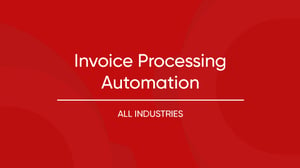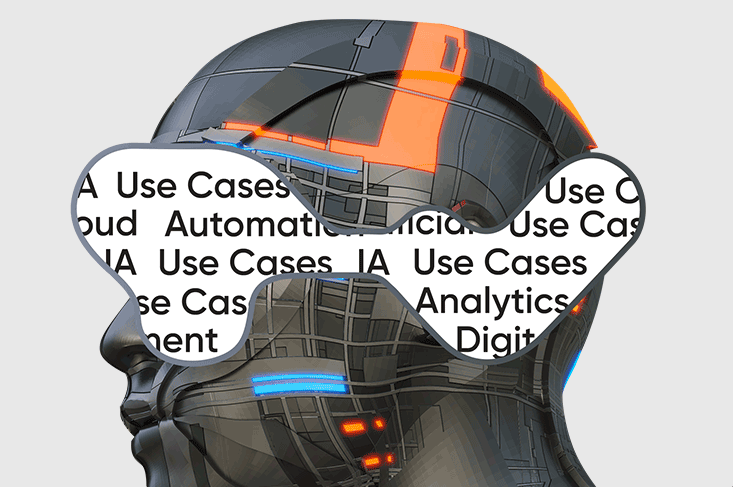
MAXIMIZE EFFICIENCY FOR MANUFACTURERS WITH INTELLIGENT AUTOMATION
50+ use cases & examples of Intelligent Automation for the Manufacturing industry.
Intelligent Automation for Manufacturing
Datamatics Intelligent Automation Platform boosts industrial ecosystem synergy. It automates value chain and function activities to improve efficiency and stakeholder response. The Integrated Platform of RPA & IDP helps manufacturers improve efficiency, end-customer experience, and competitiveness with AI.

Automation Use Cases for Manufacturing
-
Finance and Accounting
-
Reporting
-
Sales and Marketing
-
Customer Relationship Management
-
Operations
-
Product Lifecycle Management
-
Supply Chain Management

Automate invoice processing in an end-to-end manner. Use intelligent document processing to extract data points from invoices and integrate the extracted details in the Accounts Payable (AP) management system for faster processing. Integrate data between systems with Intelligent Automation and eliminate error and rework. Companies automating this process have experienced an average effort reduction by 85% and an improvement in TAT by 10x times.

Scan, transform, and automatically upload data from paper invoices into the ERP system by using Intelligent Data Capture with RPA.

Capture invoice data in the ERP system to maintain tight control over administrative and finance operations and automate routine activities in Shared Services.

Update relevant data from the Purchase Order (PO) received from the vendor into the enterprise systems as a new record. Automate paper-form order processing by using intelligent document processing. Forward the structured form of the data to the production/order dispatch department for faster execution. Forward the same to the Receivables department to generate an invoice for dispatch along with the ordered goods.

Post entries in GL, total the accounts, prepare Trial Balance, report discrepancies, manually adjust journal entries, prepare the adjusted Trial Balance, create statements, close entries, and create post-closure Trial Balance.

Auto-read the email invoice request and file attachment and log the data in the Accounting system. In case of missing information, send an email to the concerned. Else create the invoice through proper transactions.

Automate the process by inwarding the invoice in ERP, performing 2/3 way matching, notifying the concerned, and paying out if validations are in order to finally update the status in ERP.


Extract financial data from balance sheets of companies and create the credit assessment profiles before enrolling in different programs.

Receive the sales orders from the supplier vendor and auto-ingest the data with intelligent document processing and integrate with the databases for efficient management. Integrate sales orders in different business systems, such as SAP, and other siloed databases with RPA bots.

Automatically re-order spare parts and equipment in the maintenance division of your manufacturing unit on reaching a threshold.

Use intelligent document processing and RPA to search the web for potential opportunities, tenders, and RFPs and populate the data in the CRM system for review by the Sales team.

Reconcile data between bank accounts and the company database. In case of match, upload the data to the company site. If not, email it to the respective stakeholders.

Consolidate the engineering process knowledge in a single store in a standardized template with proper taxonomy to ensure quick retrievability towards problem-solving.

Automate back-office tasks for general transactions, administration, and sales. Create the building block for Intelligent Automation CoE to govern enterprise processes.

Fast-track the regulatory approvals that usually span 18 to 36 months by identifying the best candidates for medicines and vaccines from a number of clinical trials.

Collect data across the bills of material, map it against production volume to create lean inventories, and jump-start JIT operations.

Build supplier network, send RFQs, short-list suppliers, run contracts, cut POs, and onboard them.

Create a detailed list of all the parts, which are required to create a finished product, in a hierarchical manner for recurrent and on-going development.

Navigate through multiple enterprise systems to gather data across multiple touch points to resolve a service request posted through the CRM system or email.

Track the transportation of finished products through multiple carriers having multiple insurances to different warehouses, wholesalers, and retailers, and accurately calculate the shipping charges.

Report inventory, AP, AR, Pricing, and other details to the concerned stakeholders at pre-scheduled times through email, trigger alerts for abnormalities and process lacunae, and upload the report to the SharePoint folder.

Update production-related details in a web-based system from each branch, factory, and office such that a real-time status is available across the manufacturing organization.

Update status for different parameters to the intra-company databases as well as third-party and government websites for regulatory and statutory compliance.

Monitor and supervise the flow of finished goods from the manufacturing outfit to the warehouses, to the wholesalers, and then to the point of sale so that there is no stock-out.

Extract details from incoming orders in the form of email/fax, by using intelligent document processing, validate them with business rules, key in the data in the ERP, and send an initiation trigger to the production unit.

Digitize hundreds of documents, including letters of credit, validate the documents as per business rules, automate order processing and payment based on bill of lading, and email the confirmation. Automate the entire EXIM process by using intelligent document processing and RPA right from order processing to payment.

Track the products in the inventory and raise alerts to the concerned stakeholders and inform the procurement and production units when the inventory falls below a specified threshold.

Monitor and manages the raw material and parts for seamless production and send alerts to the procurement department or the vendors when it diminishes below the threshold.

Export trial balance and other related data from the ERP, determine the tax filing status of each legal entity, review accounts, reconcile inter-company transactions, calculate tax, and apply it to the trial balance.

Extract data from the bank's statements, compare it with the company records across Excel files and ERP systems, validate it against complex business rules and creates report for compliance and discrepancy.

Use RPA bots to bundle external and internal business-relevant services related to daily activities such as travel and weather sites related to business travel-related planning and improve application productivity and efficiency. Integrate online services into your web portal for easy, safe, and secure access through a proper handshake with the company IT rules.

Use RPA bots in the automobile and after-sales assistance industry to augment the emergency dispatch help function associated with the Highway Emergency Call Centre, which takes care of dispatching own fleet of resources as well as partner and contractor resources to sites of emergency incidents while on the road.

Eliminate duplication of efforts in working on the same service requests received through different channels such as web forms, telephone calls, apps, etc., by using RPA bots and send immediate customer acknowledgment.

Easily consume actual and forecast data on energy production and consumption and combine it individually with market commentary, stock exchange, and broker data.

Automate pulling in data from different legacy systems for financial reporting across the board, reduce errors involved in the manual swivel chair operations, improve productivity of the Accounting team.

Eliminate error due to manual processing of high volumes of unstructured data. Auto log in to ERP system and navigate through multiple accounts to post transactions. Auto-extract appropriate general ledgers and cross reference balances from bank statements to general ledgers. Auto-create report statements based on pre-defined criteria.

Auto-confirm if your stocks are in order. Auto-define thresholds and communicate to stores in a timely manner before conducting weekly inventory cycle audits. Auto-reconcile quantities for each brand for each store. Auto-validate all critical and high-price tag items in each store in an online mode. Track progress against an annual audit plan and track and monitor Key Risk Indicators (KRIs). Automate reports, dashboards, and scorecards to offer a bird's eye view to the management. Automatically evaluate data quality in the systems and master data files. Auto-check for completeness of fields and duplicates.

Automate invoice sourcing, requisitioning, ordering, inspection, reconciliation. Establish preferred supply chains and acquire raw material and goods from preferred vendors within pre-defined and well-negotiated budgets before the deadlines. Circumvent the over dependence on human intervention by defining upper and lower thresholds in the automated workflow. Establish strong audit frameworks with bots and enable humans to focus on other strategic initiatives.

Automate the paper work involved in shipping of goods to the customer and all the intermediate freight payments between manufacturer or shipper to the carrier (across air, land, sea) and from carrier to the customer. Automate the operations for the freight transportation - either generate or collect invoices, accounts payables cycles, data entry from internal systems to B2B portals, resolve disputes, collect structured and unstructured data, schedule and track shipments, integrate legacy systems and centralize the information generated, secure proofs of delivery, etc.

Automate the intermediate processes involved in procuring fuel for the machines involved in manufacturing and transporting raw material and finished goods. Automate the data entry from internal systems to B2B portals, collect and integrate structured and unstructured data from different formats and environments, integrate legacy systems and centralize information, generate and collect invoices, secure proofs of delivery, and read emails, by using RPA bots.

Automate the procure-to-pay (P2P) process including requisitioning, purchasing, receiving, paying for, and accounting for goods and services. Ensure significant cost reductions and improved RoI. Ensure better compliance and security through data protection and proper audit trails. Improve productivity and accuracy around the clock in 24x7 mode. Eliminate errors and delays. Reduce latency and lead times. Allow resources to focus on high-value tasks. Reduce operational costs. Improve communication and cohesiveness between different divisions. Automate procurement and inventory payment as well as order processing and payment.

Auto-compare price of goods and services between multiple providers and find lowest price. Auto-check duplication in catalog including multiple suppliers for same goods and services. Improve pricing and contract terms by identifying opportunities to consolidate suppliers.

Query carrier tracking systems and link shipping data to original orders in warehouse management systems. Improve response times and Day Sales Outstanding (DSO) metrics.

Automate cross-functional processes such as performance of estimates, ensuring product availability, performing order processing, fulfilments and logistics. Collect information from CRM, check pricing, cross-reference other software for product availability, auto-generate quotes and shipping times. Extract and validate sales order data for an approved sales order and send it downstream to other systems in order to optimize the entire sales lifecycle.

Overcome challenges pertaining to unpredictability in supplier delivery and customer demand. Perform real-time monitoring of customer demand, production capacity and inventory levels and achieve leaner and more efficient operations across the value chain

Use Intelligent Automation and maintain records as per government rules and regulations, subject to inspection under FDA requirements such as study protocols for new drug applications.

Automate payment processes required for various leases. Generate reports for multiple leases across different geographies, create metrics around profitability and projection of future trends.

Automate the prediction of demand of goods and material across multiple nodes of the value chain by digitally collaborating among the value chain partners by using RPA bots. Drive efficiency across the value chain through syndicated efforts in capacity planning, production planning, raw material planning, and replenishment planning to reduce inventory piling. Propagate just-in-time (JIT) manufacture across the value chain with RPA bots.

Automate the management of queries and escalations across the value chain with RPA bots. Collate queries and escalations received in the CRM and email at predefined frequency and route to the concerned department for quick resolution.

Auto-trigger consignment status emails and text messages across the value chain for locating a shipment and reduce queries and escalations. Improve the visibility of inventories across the value chain through a common GUI and dashboard to know the inventory status in real-time through the use of RPA bots as well as advanced visualization and analytics to support JIT manufacture.

Auto-email delivery fulfillment status to the concerned stakeholders by using Intelligent Automation.

Enable automation of return and replacement of consignments and goods within stipulated timeframes.

Receive the change request from the customer and auto-extract the details from the request form by using intelligent document processing. Route the details in a structured format to the production department to amend the order and dispatch the same. Auto-send the details to the Receivables department to amend the invoice.

Production proposals received in hard copy format tend to get lost or misplaced thus affecting the cycle time. Digitize the proposal and extract the details by using intelligent document processing. Route the details to the production department in a digitized and structured format for faster processing.

Quality Assurance (QA) records are usually created in hard copy format. This sometimes hampers the continuity and follow-ups that are mandated. Automate the QA procedures by extracting data from the paper forms and maintaining the data in a structured format on cloud ECM or a centralized database.

Intelligent Automation is a direct function of People-Process-Technology integration.
Download Now →
Download Now
Datamatics implemented RPA Tool, TruBot to automate the entire accounts payables process.
Download Now →
Download Now
The demo showcases how Datamatics IA platform automates invoice processing using RPA, AI/ML and IDP
Watch Now →
A Guide to Top 10 Most Common RPA Use Cases For Manufacturing
What you get:
- Top 10 most popular Intelligent Document Processing (IDP) and Robotic Process Automation (RPA) use cases in Manufacturing
- A list of 50+ processes that could be automated
- Proven case studies in the industry for multiple clients
- Demo videos of IDP and RPA in action
Talk To An Automation Expert
Talk to a automation expert from Datamatics about your specific challenges or queries and we will walk you through solutions that can help


